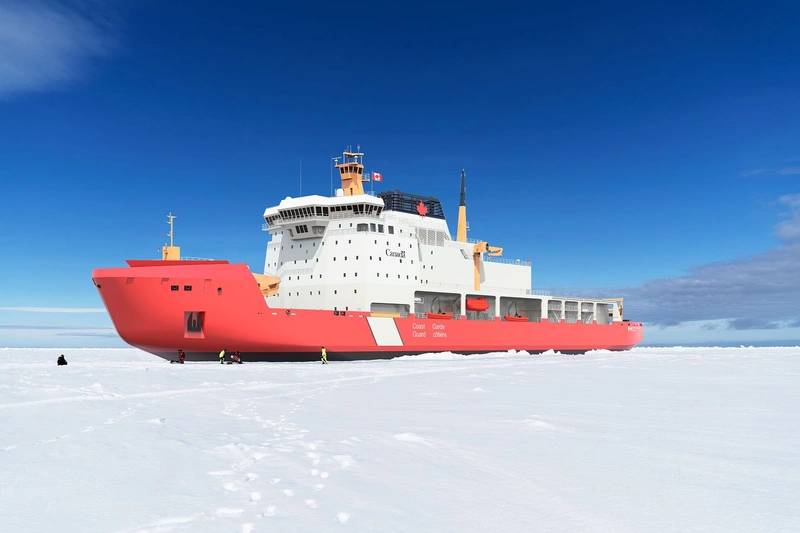Seaspan Cuts Steel on ‘Prototype Block’ for Canada's New Polar Icebreaker
Seaspan Shipyards on Tuesday cut steel to build a “prototype block” marking a critical step in the Vancouver, B.C. shipyard’s Polar Icebreaker Program.
Seaspan, which is designing and building the first heavy Polar Icebreaker in Canada in more than 60 years, said assembling the prototype block before full rate construction will allow it to test the new systems, processes, people and tools that are required to work with some of the very thick, specialized steel that needed to manufacture the complex vessel. Some of this steel will be up to 60-millimeters thick, to enable the ship to safely navigate through the multi-year ice that is found in the Arctic. The lessons learned from building the prototype block will be used to help improve the quality and efficiency of the process for designing and manufacturing the vessel when production begins in late 2024, Seaspan said.
“Cutting steel on the prototype block is a key milestone for the Polar Icebreaker Program and demonstrates Seaspan’s capabilities across engineering, design, supply chain, planning and production. The prototype is just one example of the team’s dedication to learning and continuous improvement, as we prepare to commence full rate construction,” said Martin Edwards, Chief Program Officer at Seaspan Shipyards.
Mario Pelletier, Commissioner of the Canadian Coast Guard, said, “The construction of the prototype block for the first Polar Icebreaker is an exciting milestone for us at the Canadian Coast Guard. Once completed, the Polar Icebreaker will be sailing in Arctic waters and establishing our sovereignty in the region while supporting critical work such as icebreaking operations, maritime emergencies, Arctic science research, and the safe delivery of goods and services to Northern communities. I am very excited to have arrived at this point and look forward to the start of full-rate production in the coming years.”
Seaspan Shipyards, a division of Seaspan ULC, said it has already gained significant experience designing and building Polar Class vessels under Canada’s National Shipbuilding Strategy (NSS), including three Offshore Fisheries Science Vessels which are now in service with the Canadian Coast Guard; an Offshore Oceanographic Science Vessel that is currently under construction at its Vancouver Shipyards location; and a class of sixteen Multi-Purpose Vessels (also Polar Class) that is currently in design.
The Polar Icebreaker is designed to operate in the Arctic’s ice-covered waters, and will play a critical role in enabling the Canadian Coast Guard to transit and protect more than 162,000 km of Arctic coastline. The capabilities of the Polar Icebreaker will help sustain a year-round presence in Canada’s North in support of Indigenous Peoples and other northern communities, arctic sovereignty, high-Arctic science (including climate change research), and the ability to respond to major maritime emergencies including search and rescue.
With Canada’s current largest Icebreaker, the CCGS Louis S. St-Laurent, set to retire at the end of the decade after 60 years of service, the new Polar Icebreaker will be one of the world’s largest and most powerful conventional icebreakers. The ship will be the flagship vessel of the Canadian Coast Guard’s icebreaking fleet, with a critical mission of protecting Canada’s Arctic sovereignty.
 (Image: Seaspan Shipyards)
(Image: Seaspan Shipyards)
With a displacement of 27,876 tonnes, the Polar Icebreaker will be 158 meters long and 28 meters wide, and able to accommodate up to 100 personnel. It will be able to operate farther north, in more difficult ice conditions and for longer periods than any icebreaker in Canada to date.
The primary missions of the Polar Icebreaker include protecting Canada’s sovereignty, Arctic science, environmental response, Northern resupply, and search and rescue.
Highlights of key design features, include:
- IACS Polar Class 2 (PC2) Heavy Icebreaker
- More than 40MW of installed power
- Ice-classed azimuthing propulsion system
- Complex, multi-role mission capability
- Scientific laboratories
- Moon pool (to allow for safe deployment of equipment from within the ship)
- Helicopter flight deck and hangar
- Vehicle garage and future remotely piloted aircraft system (RPAS) capability











